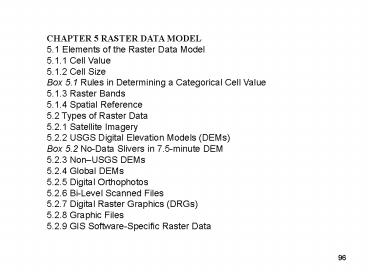CHAPTER 5 RASTER DATA MODEL - PowerPoint PPT Presentation
1 / 22
Title:
CHAPTER 5 RASTER DATA MODEL
Description:
... Raster Data Structure. 5.3.1 Cell-by-Cell Encoding. 5.3.2 Run Length Encoding ... encoded with one run, beginning in column 5 and ending in column 6. The same ... – PowerPoint PPT presentation
Number of Views:669
Avg rating:3.0/5.0
Title: CHAPTER 5 RASTER DATA MODEL
1
CHAPTER 5 RASTER DATA MODEL 5.1 Elements of the
Raster Data Model 5.1.1 Cell Value 5.1.2 Cell
Size Box 5.1 Rules in Determining a Categorical
Cell Value 5.1.3 Raster Bands 5.1.4 Spatial
Reference 5.2 Types of Raster Data 5.2.1
Satellite Imagery 5.2.2 USGS Digital Elevation
Models (DEMs) Box 5.2 No-Data Slivers in
7.5-minute DEM 5.2.3 NonUSGS DEMs 5.2.4 Global
DEMs 5.2.5 Digital Orthophotos 5.2.6 Bi-Level
Scanned Files 5.2.7 Digital Raster Graphics
(DRGs) 5.2.8 Graphic Files 5.2.9 GIS
Software-Specific Raster Data
2
5.3 Raster Data Structure 5.3.1 Cell-by-Cell
Encoding 5.3.2 Run Length Encoding 5.3.3 Quad
Tree 5.3.4 Header File Box 5.3 A Header File
Example 5.4 Data Compression Box 5.4 A Simple
Wavelet Example The Haar Wavelet 5.5 Data
Conversion 5.6 Integration of Raster and Vector
Data Box 5.5 Linking Vector Data with Images Key
Concepts and Terms Review Questions Applications
Raster Data Model Task 1 View USGS DEM Data Task
2 View a Satellite Image in ArcMap Task 3
Convert Vector Data to Raster Data Challenge
Question References
3
The Raster Data Model
- A raster represents a continuous surface, but for
data storage and analysis, a raster is divided
into rows, columns, and cells. - Raster data represent points by single cells,
lines by sequences of neighboring cells, and
areas by collections of contiguous cells.
4
Figure 5.1 A continuous elevation raster with
darker shades for higher elevations.
5
Figure 5.2 Representation of point, line, and
area features raster format on the left and
vector format on the right.
6
Elements of the Raster Data Model
- Cell value. Each cell in a raster carries a
value, which represents the characteristic of a
spatial phenomenon at the location denoted by its
row and column. The cell value can be integer or
floating-point. - Cell size. The cell size determines the
resolution of the raster data model. - Raster bands. A raster may have a single band or
multiple bands. - Spatial reference. Raster data must have the
spatial reference information so that they can
align spatially with other data sets in a GIS.
7
Figure 5.3 UTM coordinates for the extent and the
center of a 30-meter cell.
8
Figure 5.4 DEMs at three resolutions 30 meters,
10 meters, and 3 meters. The 30-m and 10-m DEMs
are USGS DEMs. The 3-m DEM is a derived product
from LIDAR data.
9
Types of Raster Data
- Satellite Imagery
- Digital Elevation Models (DEMs)
- Digital Orthophotos (DOQ)
- Bi-Level Scanned Files
- Digital Raster Graphics (DRGs)
- Graphic Files
- GIS Software-Specific Raster Data
10
Figure 5.5 USGS 1-meter black-and-white DOQ for
Sun Valley, Idaho.
11
Figure 5.6 A bi-level scanned file showing soil
lines.
12
Figure 5.7 USGS DRG for Sun Valley, Idaho. This
DRG is outdated compared to the DOQ in Figure
5.5.
13
Raster Data Structure
- Cell-by-Cell Encoding
- Run Length Encoding
- Quad Tree
14
Figure 5.8 The cell-by-cell data structure
records each cell value by row and column.
15
Figure 5.9 The run length encoding method records
the cell values in runs. Row 1, for example, has
two adjacent cells in columns 5 and 6 that are
gray or have the value of 1. Row 1 is therefore
encoded with one run, beginning in column 5 and
ending in column 6. The same method is used to
record other rows.
16
Figure 5.10 The regional quad tree method divides
a raster into a hierarchy of quadrants. The
division stops when a quadrant is made of cells
of the same value (gray or white). A quadrant
that cannot be subdivided is called a leaf node.
In the diagram, the quadrants are indexed
spatially 0 for NW, 1 for SW, 2 for SE, and 3
for NE. Using the spatial indexing method and the
hierarchical quad tree structure, the gray cells
can be coded as 02, 032, and so on. See text for
more explanation.
17
Data Compression
- Data compression refers to the reduction of data
volume. - A variety of techniques are available for image
compression. Compression techniques can be
lossless or lossy. - The wavelet transform, the latest technology for
image compression, treats an image as a wave and
progressively decomposes the wave into simpler
wavelets.
18
Figure 5.11 The Haar wavelet and the wavelet
transform. (a) Three Haar wavelets at three
scales (resolutions). (b) A simple example of the
wavelet transform.
19
Data Conversion
The conversion of vector data to raster data is
called rasterization, and the conversion of
raster data to vector data is called
vectorization.
20
Figure 5.12 On the left is an example of
conversion from vector to raster data, or
rasterization. On the right is an example of
conversion from raster to vector data, or
vectorization.
21
Landsat 7 http//landsat7.usgs.gov/ Terra /
ASTER http//terra.nasa.gov/About/ AVHRR http//ed
c.usgs.gov/products/satellite/avhrr.html SPOT http
//www.spot.com/ Indias space program http//www.
isro.org/ Japans space program http//www.jaxa.jp
/index_e.html Space Imaging http//www.spaceimagin
g.com/ QuickBird http//www.digitalglobe.com/ Inte
rmap Technologies http//www.intermaptechnologies.
com/
22
ETOPO5 http//edcwww.cr.usgs.gov/glis/hyper/guide/
etopo5 GTOPO30 http//lpdaac.usgs.gov/gtopo30/gtop
o30.asp GLOBE http//www.ngdc.noaa.gov/mgg/topo/gl
obe.html LizardTech Inc. http//www.lizardtech.com
/ ERDAS http//gis.leica-geosystems.com/ ER
Mapper http//www.ermapper.com/ Feature
Analyst http//www.featureanalyst.com USGS
status graphics for DEMs, DRGs, and
DOQs http//statgraph.cr.usgs.gov/viewer.htm Geosp
atial One-stop http//www.geo-one-stop.gov/ Massac
husetts GIS http//www.state.ma.us/mgis/mrsid.htm































